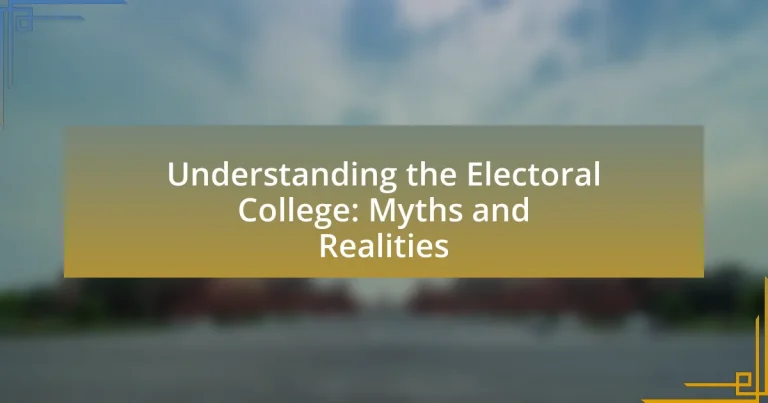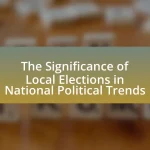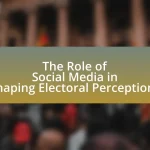The Electoral College is a constitutionally established body responsible for electing the President and Vice President of the United States, consisting of 538 electors allocated based on each state’s congressional representation. This article explores the origins, functions, and implications of the Electoral College, including its historical context, the intentions of the founding fathers, and the processes involved in electing the president. It also addresses common myths and misconceptions about the Electoral College, its impact on voter representation, and proposed reforms aimed at enhancing democratic representation. Additionally, the article examines the relationship between the popular vote and the Electoral College, highlighting the complexities and controversies surrounding this electoral mechanism.
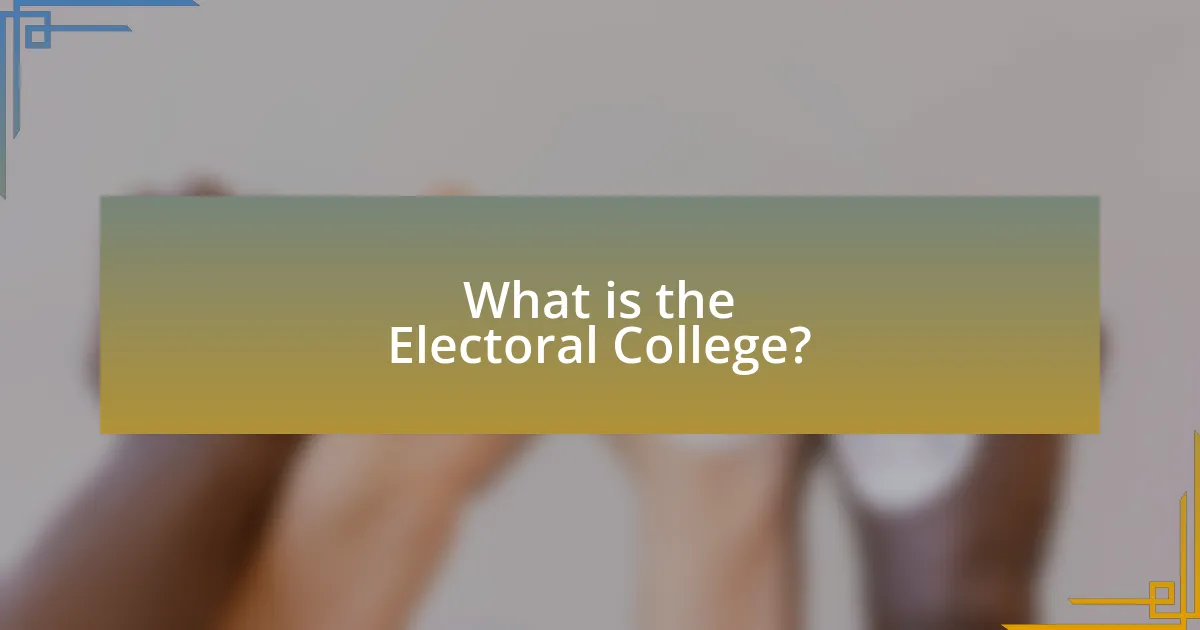
What is the Electoral College?
The Electoral College is a body established by the United States Constitution that formally elects the President and Vice President of the United States. It consists of 538 electors, with each state allocated a number of electors based on its representation in Congress, which includes both Senate and House members. The system requires a candidate to receive a majority of electoral votes, specifically 270, to win the presidency. This mechanism was created in 1787 and reflects a compromise between electing the president by a vote in Congress and by popular vote.
How was the Electoral College established?
The Electoral College was established by the United States Constitution in 1787 as a compromise between electing the president by a vote in Congress and by popular vote. The framers of the Constitution created this system to balance the influence of populous states with less populous ones, ensuring that all states had a role in the election process. Specifically, Article II, Section 1 of the Constitution outlines the mechanism for the Electoral College, which consists of electors from each state equal to the total number of its senators and representatives in Congress. This structure was designed to reflect both the federal nature of the nation and the principle of representative democracy.
What historical context led to the creation of the Electoral College?
The historical context that led to the creation of the Electoral College was rooted in the framers’ desire to balance state and federal interests while addressing concerns about direct democracy. The Constitutional Convention of 1787 revealed a divide between larger and smaller states regarding representation, prompting a compromise that established the Electoral College as a mechanism for electing the president. This system was designed to ensure that both populous and less populous states had a voice in the election process, reflecting the federal structure of the new government. The framers feared that direct popular elections could lead to mob rule and the election of demagogues, thus opting for a system that included electors chosen by state legislatures, which was seen as a safeguard against potential abuses of power.
What were the founding fathers’ intentions behind the Electoral College?
The founding fathers intended the Electoral College to balance the influence of populous states with less populous ones in presidential elections. They designed this system to ensure that smaller states would still have a significant voice in the selection of the president, preventing dominance by larger states. This intention is evident in the Constitutional Convention debates, where figures like James Madison argued for a compromise that would protect the interests of all states, regardless of size. The Electoral College reflects this compromise by allocating electors based on both state population and equal representation in the Senate, thus embodying the federal structure of the United States.
How does the Electoral College function?
The Electoral College functions as a mechanism for electing the President and Vice President of the United States, established by the U.S. Constitution. Each state is allocated a number of electors equal to its total number of Senators and Representatives in Congress, totaling 538 electors nationwide. When citizens cast their votes in a presidential election, they are actually voting for a slate of electors pledged to support their chosen candidate. Most states use a winner-takes-all system, where the candidate receiving the majority of the popular vote in that state gets all of its electoral votes. To win the presidency, a candidate must secure a majority of the electoral votes, which is currently 270. This system was designed to balance the influence of populous states with less populous ones in the election process.
What are the steps involved in the Electoral College process?
The steps involved in the Electoral College process include the selection of electors, the casting of electoral votes, and the official counting of those votes. First, each state appoints electors based on its congressional representation, totaling 538 electors nationwide. During the presidential election, voters in each state cast their ballots for their preferred candidate, and the candidate receiving the majority of votes in that state typically receives all of its electoral votes, except in Maine and Nebraska, which use a proportional system. After the election, the electors meet in their respective state capitals in December to cast their votes for president and vice president. Finally, in January, Congress convenes to officially count the electoral votes and declare the winner of the presidential election. This process is outlined in the U.S. Constitution and federal law, ensuring a structured method for electing the president and vice president.
How are electors chosen in each state?
Electors are chosen in each state through a process determined by state law, typically involving a popular vote during the presidential election. In 48 states and the District of Columbia, the candidate who receives the majority of the popular vote is awarded all of that state’s electoral votes, a system known as winner-takes-all. Maine and Nebraska use a proportional allocation method, where electoral votes can be split based on the popular vote within congressional districts. This process is outlined in the U.S. Constitution and further defined by state legislation, ensuring that electors are selected in a manner consistent with each state’s electoral framework.
What role does the Electoral College play in presidential elections?
The Electoral College is a mechanism established by the U.S. Constitution for electing the President and Vice President. It consists of 538 electors, with a majority of 270 electoral votes required to win the presidency. Each state is allocated a number of electors based on its representation in Congress, which reflects the state’s population size. This system means that voters in each state cast their ballots for a slate of electors pledged to vote for their chosen candidate, rather than directly for the candidate themselves. The role of the Electoral College is to formally elect the president, as the electors meet in their respective state capitals to cast their votes in December following the election. This process has been in place since the first presidential election in 1788, and it has shaped the political landscape by influencing campaign strategies and voter engagement across different states.
How does the Electoral College impact the outcome of elections?
The Electoral College significantly impacts the outcome of elections by determining how votes are translated into electoral votes, which ultimately decide the presidency. In the United States, the system allocates a total of 538 electoral votes, with a candidate needing a majority of 270 to win. Each state has a set number of electoral votes based on its population, which can lead to scenarios where a candidate wins the presidency without winning the popular vote, as seen in the elections of 1824, 1876, 1888, 2000, and 2016. This system encourages candidates to focus on swing states, where the outcome is uncertain, rather than concentrating on states where they are either very popular or very unpopular, thus shaping campaign strategies and voter engagement.
What are the advantages and disadvantages of using the Electoral College?
The Electoral College has advantages and disadvantages that impact the U.S. presidential election process. One advantage is that it protects the interests of smaller states by ensuring they have a proportional influence in elections, as seen in the allocation of electoral votes based on state populations. This system encourages candidates to campaign in less populous states, promoting national unity. Conversely, a significant disadvantage is that it can lead to a situation where a candidate wins the presidency without securing the popular vote, as occurred in the elections of 1824, 1876, 1888, 2000, and 2016. This outcome can undermine the principle of one-person, one-vote, leading to questions about the legitimacy of the electoral process.
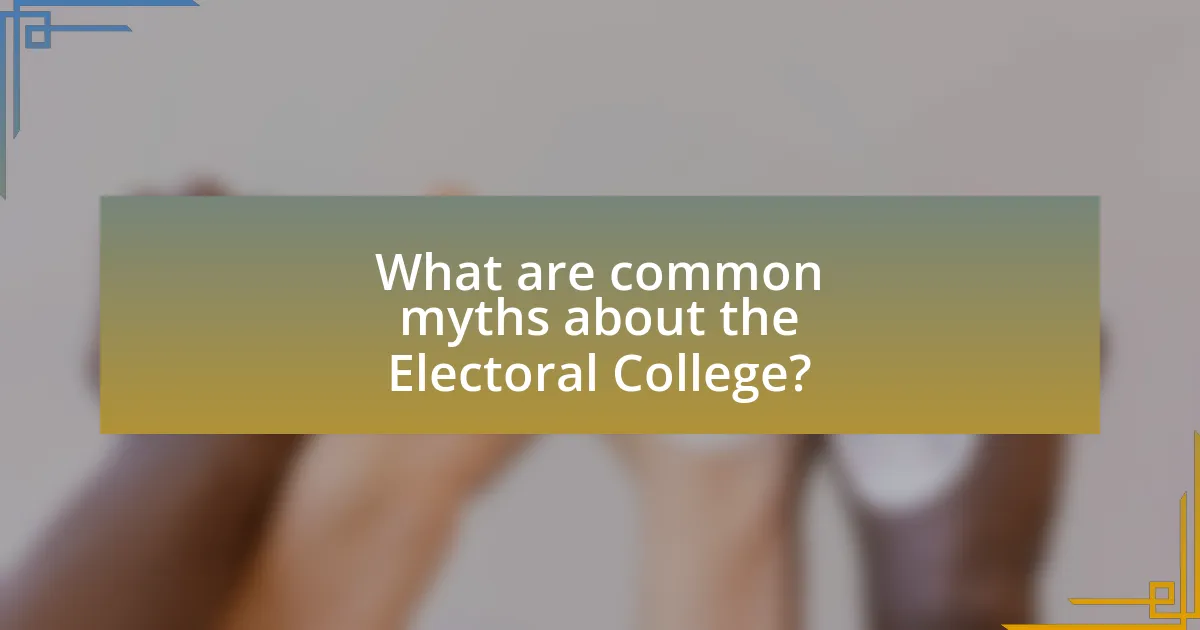
What are common myths about the Electoral College?
Common myths about the Electoral College include the belief that it directly reflects the popular vote and that electors are required to vote according to their state’s popular vote outcome. In reality, the Electoral College does not guarantee that the candidate who wins the popular vote will win the presidency, as seen in the elections of 1824, 1876, 1888, 2000, and 2016. Additionally, while most states have laws binding electors to vote for the candidate who wins the popular vote in their state, there is no federal law enforcing this, allowing for the possibility of “faithless electors.”
What misconceptions exist regarding the Electoral College’s purpose?
A common misconception regarding the Electoral College’s purpose is that it directly reflects the popular vote in presidential elections. In reality, the Electoral College was established to balance the influence of populous states with less populous ones, ensuring that all regions have a voice in the election process. This system allocates electors based on state populations, but the winner-takes-all approach in most states means that a candidate can win the presidency without winning the overall popular vote, as seen in the elections of 1824, 1876, 1888, 2000, and 2016. This highlights the Electoral College’s role in representing state interests rather than merely reflecting the national popular vote.
Why do some believe the Electoral College undermines democracy?
Some believe the Electoral College undermines democracy because it can result in a candidate winning the presidency without securing the majority of the popular vote. This has occurred in U.S. history, notably in the elections of 1824, 1876, 1888, 2000, and 2016, where the elected president received fewer popular votes than their opponent. Critics argue that this system diminishes the principle of one-person, one-vote, as votes are not equally weighted across states, leading to a disproportionate influence of smaller states in the electoral process. This perceived inequity raises concerns about the legitimacy of the electoral outcome and the overall representation of the electorate’s will.
How does the popular vote relate to the Electoral College?
The popular vote influences the Electoral College by determining how electors are allocated in each state. In most states, the candidate who receives the majority of the popular vote is awarded all of that state’s electoral votes, a system known as winner-takes-all. For example, in the 2020 presidential election, Joe Biden won the popular vote in key states like Pennsylvania and Michigan, which allowed him to secure their electoral votes, contributing to his overall victory despite losing the national popular vote in some instances. This relationship underscores the Electoral College’s role in translating popular support into electoral outcomes, while also highlighting the potential for discrepancies between the popular vote and the final election result.
What are the myths surrounding the fairness of the Electoral College?
The myths surrounding the fairness of the Electoral College include the belief that it systematically disenfranchises voters and that it favors smaller states disproportionately. Critics argue that the winner-takes-all system in most states leads to unequal representation, as candidates focus on swing states while ignoring those with predictable outcomes. However, the Electoral College was designed to balance the influence of populous states with less populous ones, ensuring that all regions have a voice in presidential elections. Historical data shows that while individual votes may carry different weights, the system aims to reflect a broader national consensus rather than a direct popular vote.
How does the Electoral College affect voter representation?
The Electoral College affects voter representation by creating a system where the votes of citizens in smaller states carry more weight than those in larger states. This is due to the allocation of electoral votes, which are based on the total number of senators and representatives a state has, leading to a disproportionate influence for less populous states. For example, Wyoming has three electoral votes despite a small population, while California, with a much larger population, has 55 electoral votes. This means that an individual vote in Wyoming has more impact on the outcome of the Electoral College compared to a vote in California, thereby skewing representation and potentially undermining the principle of one-person, one-vote.
What is the truth about swing states and their influence?
Swing states are pivotal in U.S. elections because they can be won by either major political party, significantly influencing the outcome. Historically, swing states like Florida, Ohio, and Pennsylvania have determined presidential elections due to their unpredictable voting patterns. For instance, in the 2020 election, Joe Biden’s victories in key swing states contributed to his overall electoral win, highlighting their critical role in the Electoral College system. The importance of swing states is further evidenced by the fact that candidates often focus their campaign efforts and resources on these areas, as winning them can lead to securing the necessary electoral votes for victory.
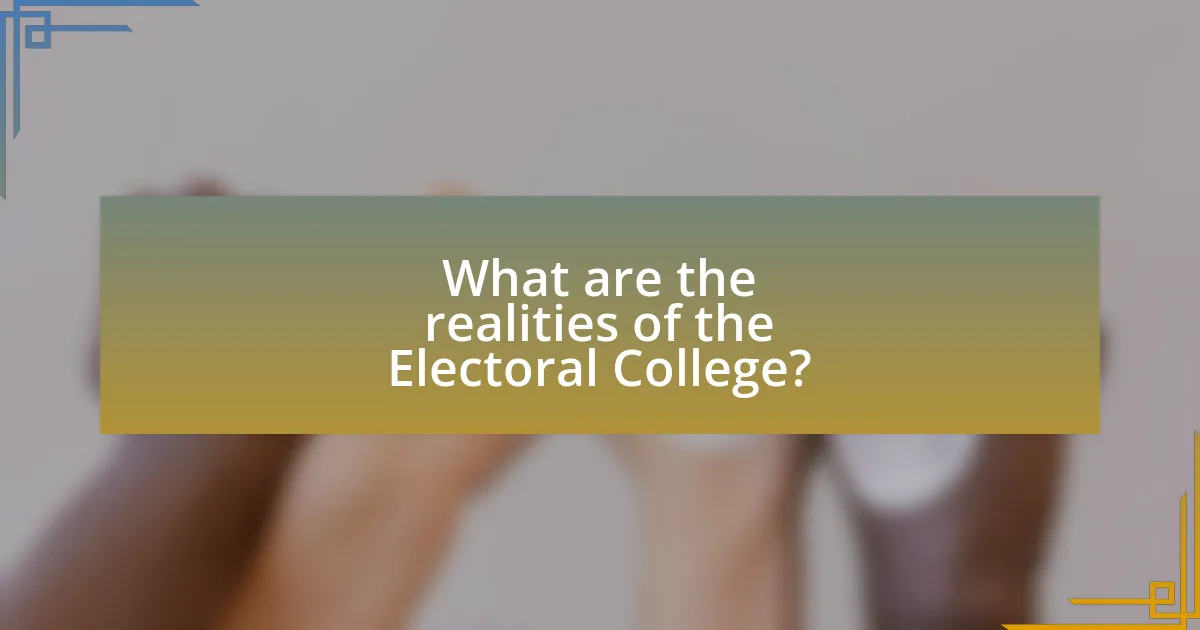
What are the realities of the Electoral College?
The Electoral College is a mechanism established by the U.S. Constitution for electing the President and Vice President, consisting of 538 electors. Each state is allocated a number of electors based on its representation in Congress, which can lead to scenarios where a candidate wins the presidency without winning the popular vote, as seen in the elections of 1824, 1876, 1888, 2000, and 2016. This system can result in unequal representation, as smaller states have a disproportionately higher number of electors relative to their population size. Additionally, the winner-takes-all approach used by most states means that candidates focus on swing states, often neglecting those with predictable outcomes. These realities highlight the complexities and controversies surrounding the Electoral College, raising questions about its effectiveness and fairness in modern elections.
How does the Electoral College reflect the will of the people?
The Electoral College reflects the will of the people by translating the popular vote into a mechanism for electing the President of the United States. Each state allocates its electoral votes based on the outcome of the popular vote within that state, ensuring that the choice of the electorate influences the final decision. For instance, in the 2020 election, Joe Biden received 51.3% of the popular vote, which translated into 306 electoral votes, demonstrating how the majority’s preference was represented in the electoral outcome. This system aims to balance the influence of populous states with less populous ones, thereby reflecting a broader national consensus while still prioritizing state-level voting outcomes.
What evidence supports the effectiveness of the Electoral College?
The effectiveness of the Electoral College is supported by its role in maintaining a balance between populous and less populous states in presidential elections. This system ensures that candidates must appeal to a diverse range of voters across different regions, rather than focusing solely on densely populated urban areas. Historical evidence shows that the Electoral College has successfully facilitated the election of presidents who represent a broad coalition of states, as seen in the elections of 1824, 1876, and 2000, where the candidate winning the presidency did not secure the popular vote but garnered the necessary electoral votes. Additionally, studies indicate that the Electoral College encourages candidates to campaign in a variety of states, promoting national unity and engagement in the electoral process.
How do electoral votes correspond to population distribution?
Electoral votes correspond to population distribution through a system that allocates votes based on the number of representatives and senators each state has in Congress, which is determined by its population. Each state receives a minimum of three electoral votes, regardless of population, due to the two senators and at least one representative it has. This means that less populous states have a disproportionately higher number of electoral votes per capita compared to more populous states. For example, Wyoming, with a small population, has three electoral votes, while California, with a much larger population, has 55 electoral votes, illustrating the imbalance in representation. This allocation method can lead to scenarios where the popular vote does not align with the electoral vote outcome, as seen in the 2000 and 2016 presidential elections.
What reforms have been proposed for the Electoral College?
Proposed reforms for the Electoral College include the National Popular Vote Interstate Compact, which aims to ensure that the candidate receiving the most votes nationwide becomes president by having states pledge their electoral votes to the national popular vote winner. Additionally, some advocates suggest abolishing the Electoral College entirely in favor of a direct popular vote system, arguing that it would enhance democratic representation. Other proposals involve modifying the allocation of electoral votes, such as using proportional representation instead of the winner-takes-all approach currently employed by most states. These reforms are supported by various political groups and scholars who argue that the current system can lead to discrepancies between the popular vote and electoral outcomes, as evidenced by instances like the elections of 2000 and 2016, where the candidates who lost the popular vote won the presidency.
What are the arguments for abolishing the Electoral College?
The primary argument for abolishing the Electoral College is that it undermines the principle of one-person, one-vote, leading to unequal representation. This system allows candidates to win the presidency without securing the majority of the popular vote, as evidenced by the elections of 1824, 1876, 1888, 2000, and 2016, where the winning candidates lost the popular vote. Additionally, the Electoral College disproportionately amplifies the influence of smaller states, resulting in candidates focusing their campaigns on a few battleground states while ignoring larger states with more voters. This creates a disparity in campaign attention and resources, further entrenching the inequities in the electoral process.
How could changes to the Electoral College impact future elections?
Changes to the Electoral College could significantly alter the dynamics of future elections by shifting the balance of power between states and potentially increasing voter participation. For instance, if the Electoral College were replaced with a national popular vote system, candidates would likely focus more on populous states, thereby encouraging higher voter turnout in those areas. Historical data from the 2000 and 2016 elections, where the popular vote winner did not secure the presidency, illustrates the potential for disenfranchisement among voters in states with less electoral influence. Additionally, reforms such as proportional allocation of electoral votes could lead to more competitive elections by allowing third-party candidates a better chance of gaining traction, thereby diversifying the political landscape.
What should voters understand about the Electoral College?
Voters should understand that the Electoral College is the system used to elect the President of the United States, where each state has a certain number of electoral votes based on its population. This system means that winning the popular vote does not guarantee a presidential victory, as seen in the elections of 1824, 1876, 1888, 2000, and 2016, where candidates won the presidency despite losing the nationwide popular vote. The Electoral College consists of 538 total votes, and a candidate needs a majority of 270 to win. This structure can lead to scenarios where the distribution of electoral votes does not reflect the overall popular vote, emphasizing the importance of understanding how individual state voting impacts the national outcome.
How can voters engage with the Electoral College process effectively?
Voters can engage with the Electoral College process effectively by participating in state-level elections and advocating for reforms that align with their preferences. Engaging in local and state elections is crucial because these elections determine the electors who will represent the voters in the Electoral College. According to the National Association of Secretaries of State, understanding state laws regarding the selection of electors can empower voters to influence how their votes are counted. Additionally, voters can support initiatives that promote the National Popular Vote Interstate Compact, which aims to ensure that the candidate receiving the most votes nationwide becomes president, thereby enhancing the relevance of individual votes in the Electoral College system.
What resources are available for learning more about the Electoral College?
Resources for learning more about the Electoral College include educational websites, books, and academic articles. Websites such as the National Archives and Records Administration provide official information about the Electoral College’s history and function. Books like “The Electoral College: A Critical History” by Robert M. Hardaway offer in-depth analysis and context. Additionally, academic articles from journals such as the “American Political Science Review” present research findings and discussions on the implications of the Electoral College in modern elections. These resources collectively enhance understanding of the Electoral College’s role in the U.S. electoral system.
